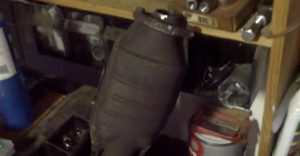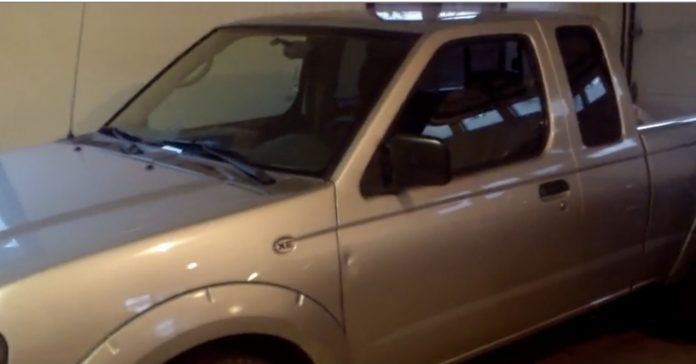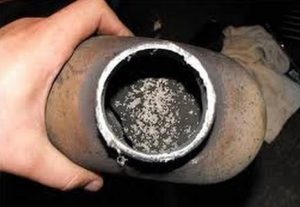A few weeks back, most of my truck’s exhaust system fell off. I decided to save back some money – a financial survival skill these days – by not replacing all of what fell off. Specifically, one of two catalytic converters my truck originally came with – these being both expensive and restrictive. The latter of which also constitutes an expense, one most people are unaware they’re paying.
Each “cat” by itself costs several hundred bucks, if you get an original equipment/vehicle-specific cat. One can spend less by buying a universal/generic-fit cat, but that may end up costing you in the short and long run. In the short run, because the universal/generic cat you buy may and probably will be low quality, relative to the original. Sometimes, this doesn’t matter as much when the part isn’t functional.
A “cheap” one may fall off (again) sooner – and that isn’t going to save you money. It may also not flow as well, which will also cost you money, even if you don’t notice that you’re spending it. Which brings me back to why I decided to not replace my truck’s second cat at all. Or rather, chose to replace it with a section of straight pipe and a high-flow muffler.
By not buying the second cat, I had the money to spend on the pipe and muffler, plus some mounting hardware. With plenty of money left over, relative to what I’d have spent on just the cat, even a “cheap” universal-fit unit. In fact, I had enough left over to pay for a couple of tankfuls of gas, which saves me a lot in the context of what the Biden Thing is costing me (and you, too).
And that brings me to saving on gas, going forward.
The cat that fell off was more than 20 years old. Have you ever looked inside a 20-year-old catalytic converter? If you haven’t, here’s what you’ll see: A kind of honeycomb lattice of scores of tiny passages that the exhaust gas must pass through before exiting the exhaust system. Over time, carbon builds up on the surfaces of these extremely tiny passages through which the exhaust must pass. Inevitably, flow is restricted as these passages narrow. Sometimes, the fouling can be heavy enough to plug the cat such that the engine won’t run at all, or doesn’t run very well.
All the while – and prior, until it becomes so noticeable you can’t help but notice – your vehicle will burn more gas, costing you more money.
The usual fix is to buy a new cat, which gets things back to where they were when the vehicle (and its exhaust system) were new. I decided to fix it even more, the way we used to do it back in the day – when it was understood that even a new cat was an impediment to both power and mileage. Especially the first generation cats, such as the pellet-type that my 1976 Trans-Am had originally. The poor V8 had to push air through a pair of restrictive exhaust manifolds that fed two pipes that fed into one pellet-style cat before heading back to the muffler and out the splitters (the Trans-Am’s signature exhaust tips).
Merely by replacing the single cat with a pair of pipes – one for each side of the V8 – feeding two low-backpressure mufflers – resulted in a noticeable horsepower uptick as well as better gas mileage.
And that’s why I did the same to my truck.
It is noticeably peppier now, probably because there is significantly less restriction in the exhaust. It is the vehicular equivalent of not trying to go for a jog while wearing two or three Face Diapers. It also uses less gas, which will answer the probable outrage of “environmentalists” reading this account.
Using less gas means “emitting” less gas – especially the dread gas, carbon dioxide, that millions of well-trained neurotics believe – emphasis on the religious aspect – is causing the “climate” to “change.” If my truck goes say 2 miles farther on a gallon of gas than it did before, then I have substantially reduced my truck’s “emissions” of the dread gas, C02. Far more so than the literally fractional reductions achieved by such expensive means as cycling the engine off as often as possible (i.e., ASS – automated stop/start “technology”) and hybridizing the drivetrain, to say nothing of “electrifying” it.
And the truck still has its other cat, the one snugged up against the engine – which was all it needed, probably, to reduce 98-plus percent of the truly harmful emissions, which aren’t C02. Those were all-but-eliminated decades ago, with only fractional gains made since then – though these are always presented as major gains by not explaining to people that a “50 percent” reduction of .03 percent doesn’t amount to much.
I’ve probably done more for the environment than all the “environmental” regulations of the past 20 years.
Plus saved back a bunch of money.
The truck sounds great, too!
. . .
Got a question about cars, Libertarian politics – or anything else? Click on the “ask Eric” link and send ’em in! Or email me at EPeters952@yahoo.com if the @!** “ask Eric” button doesn’t work!
If you like what you’ve found here please consider supporting EPautos.
We depend on you to keep the wheels turning!
Our donate button is here.
If you prefer not to use PayPal, our mailing address is:
EPautos
721 Hummingbird Lane SE
Copper Hill, VA 24079
PS: Get an EPautos magnet or sticker or coaster in return for a $20 or more one-time donation or a $10 or more monthly recurring donation. (Please be sure to tell us you want a magnet or sticker or coaster – and also, provide an address, so we know where to mail the thing!)
My eBook about car buying (new and used) is also available for your favorite price – free! Click here. If that fails, email me at EPeters952@yahoo.com and I will send you a copy directly!













My 08 Subaru has bad cats and they will not get replaced. My county requires that I pass an emission test in order to be registered. I am going on month eight of non-compliance.
Hi Andrew,
You could gut the clogged converters and then re-install the shells. They appearance would pass visual and so long as the MIL (“check engine”) light does not come on during the test, you ought to pass.
FYI – My truck’s MIL has not come on yet!
The exhaust on my 05 sprinter work van was fairly well disintegrated so I looked up the price for muffler/cat combination (they’re fabbed together as one piece.) Cheapest I could find at the time was around 1300.00 just for parts. I decided to cut off the exhaust just past the Turbocharger flex fitting and re-pipe it , ust replaced the muffler with a high flow model not cat. Diesels aren’t emission tested in my area so no problems there and this model is pre DEF piss tank so no engine codes came up as a result.
Gained a little low end torque and hp 10-15 maybe 1-2 mpg gain at best. Whole job cost me less than $400.00 and one Saturday of my life it sounds and smeels like a diesel. No regrets.
Where ya at, Hitman?
Been wondering what if I took my Dads car (’18 range rover), registered it in a state or area without emissions, gutted the Emissions crap (Diesel) and drove it here in Dirty Jersey/New York.
Zane. I’m in Kentucky.
Not sure if you’d need proof of residence or other what-nots. But there are no smog inspections here. They do a vehicle inspection brake lights, turn signals nothing too intense and run your VIN to see if it’s been reported stolen if it’s currently registered out of state
Sic,
Even that ‘inspection’ is only when you bring in a vehicle from out of state to title here in KY.
What I usually recommend: High flow for the primary and gut the secondary, gain lots of power that way, make some $$$ back selling them and have a happy and healthier vehicle
Eric, don’t forget that as that dead “cat” contains precious metals don’t just throw it out, recycle it (scrapyard) and you will be even more environmentally friendly!!
EXCELLENT, Eric! That was an all-around win! I have nothing much to add- just wanted to say kudos for what you did, and for being one of the few voices to herald the actual facts related to the myriad benefits of doing so!
But, since it is not at all like me to post such a short comment, I will regale yous[sic] with an amusing anecdote related to catholic-converters!
Had this friend back in NY who was a diesel mechanic for UPS, who would also fix cars at home as a second source of income. He was not the best diagnostician of the OBD I gas engines which were thge norm at the time, so every time someone would bring him a car that wasn’t running properly- e.g. lacked power, surged, etc. if he could not figure out the source of the problem after a rather rudimentary evaluation, he would always blame a clogged cat!
I’d often show up at this guy’s house as he was in the midst of hollowing-out someone’s cat (And of course, since clogged cats were not all that common on that era of vehicles, it would almost never cure the symptoms for which the car was brought in). Once I hanging around as he was hollowing out a cat with sledge hammer and chisel, and he misses the chisel and hits his own hand.
I was bracing myself for a loud stream of profanities, but I think this time it was beyond that…as he just knelt there motionlessly by the cat and tools on the ground, and looked up at his wife and calmly and deliberately uttered in almost a whisper “The price just went up”.
Nunz, that little story was priceless!
And: I can report that – so far – the MIL (check engine) light has not come on, after several days of driving. The truck seems to have gained 10 horsepower, too!
The “Check Engine” light being a MIL….LOL, how fitting, and to think that these new cars have several MIL’s. One would think that one was bad enough. And there again, I was always told I think too much…
Cats rob power
As I said just now, gut the secondary and if you got emissions, do a high flow for the primary
Had a commercial plated Ram Rebel, high flows were the size of soda cans, passed without issue
Good story N. I have to caution against this though, I did it a couple times and found out the hard way that not only is the platinum/palladium/rhodium toxic, there is an asbestos blanket wrapped around the core in at least some of them. So gutting a cat is not a hazard free enterprise, on the gripping hand this is one of the few situations where wearing a mask is actually not a bad idea.
I’m at this decision point with the 91 Silverado. I can hack pipes, seal and clamp, with or without a new CAT. It has the original now, it isn’t plugged but I’m sure the restriction is significant now, runs great around town but freeway speeds it’s low on power on grades.
A Magniflow replacement requiring some pipe fitting is $128, pipes and clamps another $60 or so for stainless. Humm. I don’t like smelly exhaust so I may do the CAT but I’ll be mad if it plugs quickly. Truck isn’t an oil burner, tuning is correct. One thing in a 91 is the EGR is calibrated for certain level of back pressure so a full removal may screw that up.
100-200 cell custom cat
I would like to do this with my old junker A6 wagon. The original cats fouled years ago. I got a local shop to replace them (very reluctantly) with aftermarket cats. The Audi cats were $7000 for the pair! I got the aftermarket for less than $1K — I forget the exact amount.
That was in the hopes that it would fix the O2 sensor and the CEL. It did for about two months. And now, years gone by, the hopes of reselling that car to anyone but the junk yard are long gone.
We don’t have smog checks here in St. Mary’s county. I think it’d be smarter to have those aftermarket cats replaced with straight pipe. Especially since that engine burns oil like it’s going out of style.
But where in hell can I find someone willing to do it?! The shops around here don’t want to modify any car apparently. They don’t even want to put on aftermarket window regulators!
Hi EM,
All you need is a floor jack, a hacksaw and some determination! Just hacksaw the old cats out and sub in a section of pipe to reconnect the break. Secure with clamps and you’re done!
Guy in my AO used to take the cats off the vehicle and ram a crowbar right down the middle until all that honeycomb was mixed with the gravel on the driveway.
Yeah, Eric, depending on your model year, that first cat is essential, because the downstream O2 sensor will freak out if the fuel rich/lean oscillation created by the upstream O2 has not been corrected.
There is a simple solution…
Obtain a “spark plug anti-fouler” and install it between the sensor and the exhaust pipe. This places the O2 sensor away from the exhaust stream. These anti-foulers have the same thread size as an O2 sensor. A tip for O2 sensor removal…it is easier to remove them from a hot exhaust system than a cold system.
Wonder how much evil CO2 that volcano in Hawaii is “emitting” 😆 not to mention the other noxious gases along with it. The hubris of the PTB in thinking humans can control the planet’s climate never ceases to amaze me.
Mike,
They don’t think humans can, which is why we need their saintly guidance. Because only THEY can. But after all, the Psychopaths In Charge are all mentally ill.
Never any investigation by the Media into what, exactly, is the Gov plan for “fixing” climate change via all the extra taxes, cap and trade (?). They just nod their heads confirming they are nothing but brainwashed cult believers.
Here we get another 46 cents a gallon gas tax in January. Governor says “to fight climate change” – how? Never asked. What’s the plan, for all that dough?
>The hubris of the PTB in thinking humans can control the planet’s climate never ceases to amaze me.
Amen to that, Mike.
Quick! Let’s pass a law against volcano emissions!
And when that doesn’t work, it will be time to appease the Volcano God with some human sacrifice. Let’s see now, who can we select? Why, Evil White Men, of course!